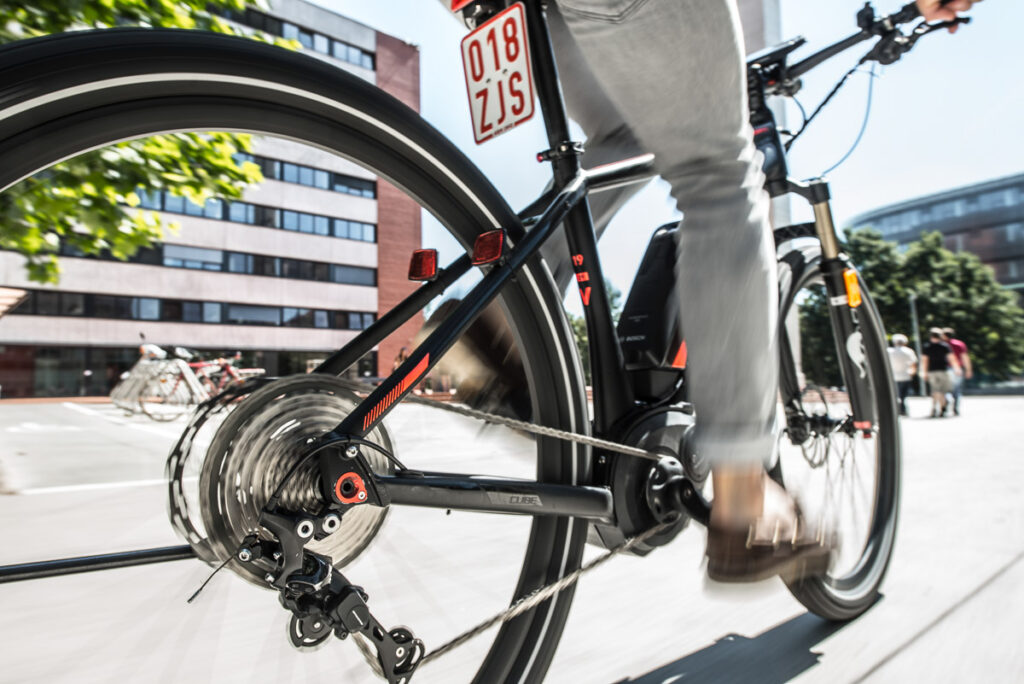Which German cities have made it into the top 20 most bicycle-friendly cities?

- Three German cities among the 20 most bicycle-friendly cities worldwide
- However, a national ranking shows some discrepancies and raises questions
- Share of cycling in Germany: average with potential for improvement
Which is the most bicycle-friendly city?
Copenhagen is currently the most bicycle-friendly city in the world! At least according to the “Copenhagenize Index” from June 2017. The Danish Copenhagenize Design Company publishes an index every two years in which the 20 most bicycle-friendly cities in the world are ranked. Three major German cities also made it into the top 20 in 2017. But first things first: What actually makes a bicycle-friendly city? And how do German cities fare in terms of bicycle friendliness?
Please be (bicycle) friendly
The Copenhagenize Index takes into account a total of 14 different criteria to assess the bicycle-friendliness of a city. These criteria include
- Cycling infrastructure
- Cycling culture
- Bike sharing programmes
- Traffic calming
- Acceptance of cyclists
- Urban planning
Other criteria include the proportion of people wearing helmets or bicycle facilities such as bicycle ramps on stairs, public parking stations and parking spaces for bicycles on buses and trains. So when assessing bicycle-friendliness, the focus is undoubtedly on cycling and cyclists. Cycle-friendly cities are characterised by a well-developed network of cycle paths and cycle lanes. Urban planners are now placing more and more emphasis on cycling infrastructure. Traffic calming through, for example, speed 30 zones and the general acceptance of car drivers for cyclists also play an important role in this context.
German cities in 10th, 15th and 17th place
Copenhagen successfully defended its first place from the last ranking in 2015. Close behind were the two Dutch cities from Utrecht and Amsterdam. As the most bicycle-friendly German city, Berlin can distinguish itself with 10th place. The other two German metropolises are Munich in 15th place and Hamburg in 17th place. It is striking that only two cities outside Europe made it into the ranking at all, Tokyo (9th place) and Montréal (20th). Meanwhile, France has the most cities in the Copenhagenize Index 2017 with Strasbourg, Bordeaux, Paris and Nantes.
Copenhagenize Index 2017
- Copenhagen, Denmark
- Utrecht, Netherlands
- Amsterdam, Netherlands
- Strasbourg, France
- Malmö, Sweden
- Bordeaux, France
- Antwerp, Belgium
- Ljubljana, Slovenia
- Tokyo, Japan
- Berlin, Germany
- Barcelona, Spain
- Vienna, Austria
- Paris, France
- Seville, Spain
- Munich, Germany
- Nantes, France
- Hamburg, Germany
- Helsinki, Finland
- Oslo, Norway
- Montréal, Canada
Source: http://copenhagenize.eu/index/index.html
German cities in nationwide comparison
A comparison between the international index of bicycle-friendly cities of the Copenhagenize Design Company and the 2016 Bicycle Climate Test of the ADFC (Allgemeiner Deutscher Fahrrad-Club) shows huge differences. The ADFC Bicycle Climate Test is the satisfaction index of cyclists in Germany. A total of over 120,000 citizens assessed the cycling climate in 539 German cities. The main criteria in this test are, for example, safety on bicycles and whether cycling in the respective city is fun or rather stressful. The result is – at least in view of the Copenhagenize Index – astonishing. Berlin, for example, is ranked 36th among the 39 cities (with at least 200,000 inhabitants) evaluated. Hamburg does not fare particularly well either, in 31st place. Only Munich, in 13th place, at least comes close to matching its ranking in the international index

ADFC Cycling Climate Test 2016
1 Münster
2 Karlsruhe
3 Freiburg
4 Bremen
5 Hannover
…
12 Frankfurt am Main
13 München
…
31 Hamburg
…
36 Berlin
37 Köln
38 Mönchengladbach
39 Wiesbaden
Source: http://www.fahrradklima-test.de/misc/filePush.php?mimeType=application/pdf&fullPath=/files/2/5/ADFC-FKT_2016_Staedteranking.pdf
Germany’s “Cycling Capital” Secures 1st Place
Some of you may have heard that Münster is THE cycling city in Germany. No wonder, since the share of cycling traffic here is a whopping 38%. The result of the Cycling Climate Test underlines Münster’s supremacy in a nationwide comparison. Karlsruhe, Freiburg, Bremen and Hanover follow in second to fifth place. Behind Berlin (36) there are only 3 German cities: Cologne, Mönchengladbach and Wiesbaden. Now, it can certainly be argued that the different criteria used as a basis for evaluation alone cause such differences. In addition, the Copenhagenize Index is not based on surveys of cyclists, but on specially prepared studies and their results. The enormous contrast, especially in relation to Berlin, but also to Hamburg, is nevertheless astonishing. Also worth mentioning are Bochum, Wuppertal and Augsburg, which showed the best development compared to the last Cycling Climate Test in 2014.
Hamburg a bicycle-friendly city?!

The astonishment about the results of the Copenhagenize Index 2015 are also reflected in a blog post of “Zeit Online”. There, the ranking, even the nomination alone of the Hanseatic City of Hamburg was strongly criticised. The decisive factor was Hamburg’s placement (then in 19th place) in the ranking of the most bicycle-friendly cities worldwide. According to the article, Hamburg is anything but a cycling city and accordingly has no place in this ranking. This viewpoint, in turn, fits with the results of the 2016 German Cycling Climate Test, where Hamburg received an overall rating of 4.19, placing it in the bottom third of the ranking nationwide.
Bicycle-friendly city = bicycle city?
After looking at the two indexes, however, a few questions arise. What does the status of “bicycle-friendly city” actually mean for cyclists? Is a bicycle-friendly city automatically a bicycle city? To answer this question, the two terms must first be distinguished from each other:
In a bicycle-friendly city, the bicycle should be considered equal to motorised traffic. The aim is to promote modern and environmentally friendly mobility. In addition, traffic in a bicycle-friendly city should be relieved by the highest possible share of cycling and be perceived as safe by cyclists.
A cycling city is defined by a high share of cycling among its inhabitants (and tourists). Accordingly, cycling is of particular importance, as both city administration and politics ascribe an extremely high value to cycling.
The main difference is therefore probably somewhere between theory and practice. While in theory a bicycle-friendly city has all the conditions for safe cycling, a cycling city is considered to be just that, if in practice there is a high proportion of traffic made up of cyclists.
Houten is the secret cycling champion
So what is the relationship between “theory and practice” in reality? Copenhagen, for example, as the most bicycle-friendly city in the world, is definitely also considered a cycling city with a cycling share of about 30%. The same goes for Amsterdam with around 32% cyclists in urban traffic. Antwerp also shines with a cycling share of 23%. Munich (14%), Berlin (13%) and Hamburg (12%) are clearly behind here, but are in the middle of the pack in Europe. Other cities from the Copenhagenize Index 2017 are sometimes even significantly behind the 3 largest German cities. While Helsinki is still just behind with 11%, Vienna (7%), Seville (6%), Oslo (5%) and Paris (3%), for example, are already somewhat behind. The cycling city of Münster has a strong 38% share of cycling in these statistics. The leader is the Dutch city of Houten with 44%, followed by the German city of Oldenburg (43%).

Mobility survey of the VCÖ 2016
Houten (NL) 44 percent
Oldenburg (DE) 43 percent
Eindhoven (NL) 40 percent
Groningen (NL) 40 percent
Münster (DE) 38 percent
Amsterdam (NL) 32 percent
Kopenhagen (NL) 30 percent
Bremen (DE) 25 percent
Antwerpen (BE) 23 percent
München (DE) 14 percent
Berlin (DE) 13 percent
Hamburg (DE) 12 percent
Helsinki (FI) 11 percent
Wien (AT) 7 percent
Sevilla (ES) 6 percent
Oslo (NO) 5 percent
Paris (FR) 3 percent
Source: https://www.vcoe.at/news/details/vcoe-oesterreichs-staedte-haben-beim-radverkehr-im-eu-vergleich-aufzuholen

Copenhagen and Amsterdam as role models
A bicycle-friendly city is therefore not necessarily a cycling city with a high share of cycling. The Copenhagenize Index also places great emphasis on projects planned for the future that are intended to make a city more bicycle-friendly and thus a cycling city. This should also be the incentive for German cities, as there is still a lot of room for improvement in this respect. There is plenty of room for improvement to make transport in German cities more environmentally friendly and safer. With Copenhagen and Amsterdam, there are also two excellent role models that are not far from us. Some smaller German cities such as Münster or Oldenburg are also good examples of the fact that bicycle-friendly cities are also quite possible in Germany. This must also be a goal of Germany’s major cities for the future. Bremen, for example, with just over half a million inhabitants, shows that cycling can also be given a high priority in larger cities.


















Recent Comments